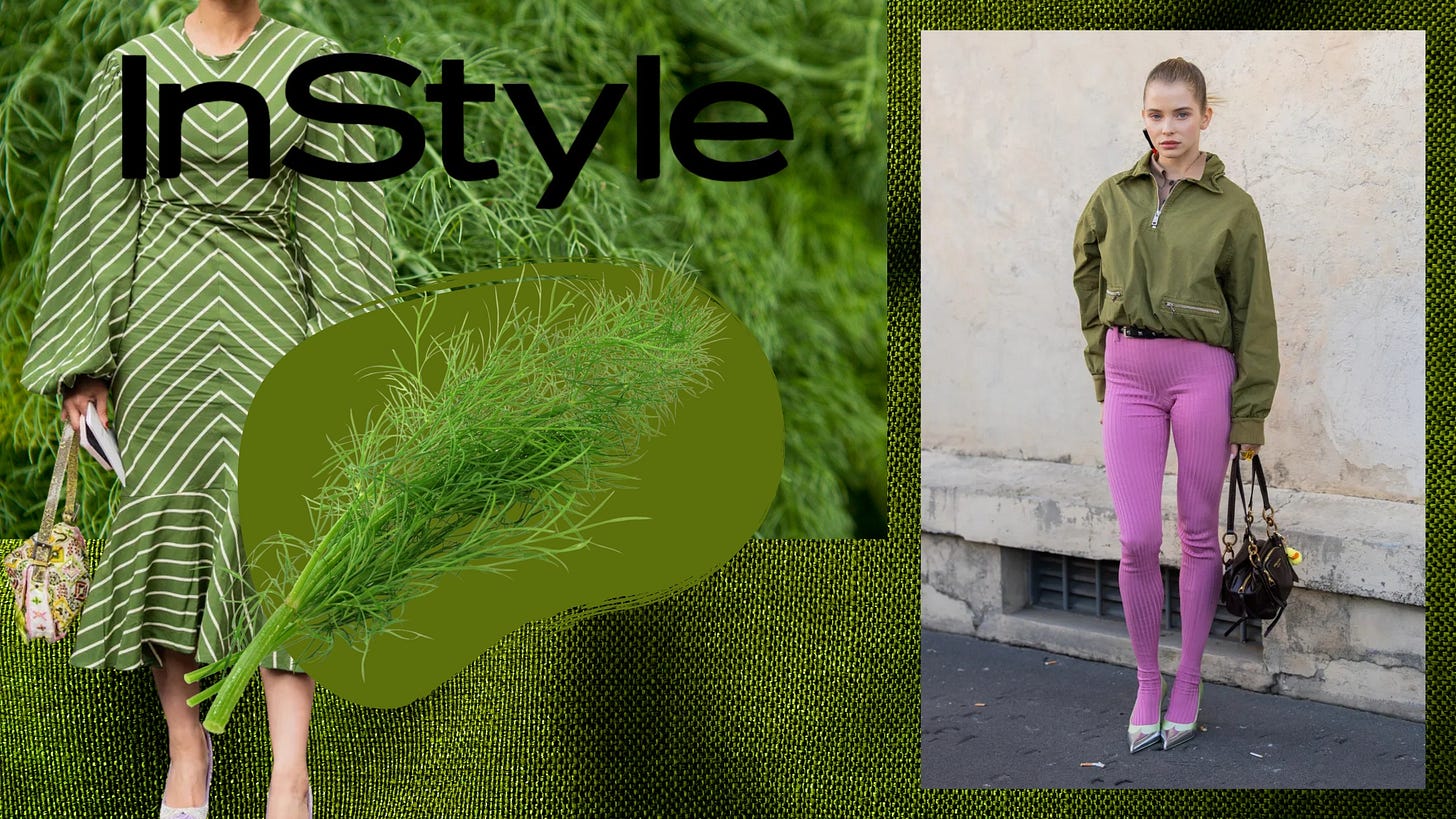When Fashion Gets a Little Pickled
Reflections from my InStyle July 2025 feature on the summer's most unexpected hue.
There’s something delightfully strange about opening a fashion magazine and seeing the word pickle in bold type. Even stranger: seeing your own name beneath it.
And yet, there I was in InStyle, quoted in a feature about summer’s breakout shade: dill green — a color inspired by crunchy condiments and 1970s nostalgia. A color I never would’ve guessed would go viral… until it did. Until it made sense.
This wasn’t just trend forecasting. It was an emotional temperature check.
A Little Bit Sour, A Little Bit Soothing
When the editors asked why I thought green was making a comeback, my first instinct wasn’t aesthetic. It was psychological.
Green represents growth, renewal, peace, balance, and harmony.
Green is, by nature, a paradox: it’s soothing and alert, grounding and fresh, familiar and new. It shows up in times of transition—after burnouts, after endings, after long winters (literal or emotional).
And dill green? That particular shade carries extra weight. It’s not neon, not avocado, not forest. It’s briny, almost weird. It tickles memory. The kind of green you’d find on a 1970s kitchen tile, a picnic blanket, a plastic Tupperware lid. It's the color of texture, of taste, of some odd corner of your childhood that felt safe and absurd.
It calms and tickles at the same time. That duality — soothing and surreal — is exactly what makes it so compelling.
Why Pickles?
It’s a fair question. Why are pickles (and tomatoes, and sardines) suddenly inspiring runway fashion?
Because food is emotionally loaded. It’s memory, ritual, belonging. It has texture, story, identity. And in a world that’s felt emotionally starved, fashion is finally leaning toward sensory play.
“Fashion is shifting from performance to feeling. In uncertain times, we don’t just want aesthetics — we want texture, taste, and story.”
— InStyle
We’re dressing less to impress, more to express.
Less for performance, more for pleasure.
In the interview, I called this joyful eccentricity. That little spark of silly boldness that says:
I care how I feel, not just how I look.
Dill green is absurd in the best way — it’s a color with a wink. Low-stakes joy in textile form. Something that feels like a mood reset, without requiring reinvention.
Styling the Mood (Not Just the Shade)
In the article, I offered a few tangible ways to approach the trend, but here’s the fuller context:
If you're the bold type? Go full dill. Co-ord sets, sundresses, or even a monochrome moment can feel playful and intentional.
If you're more tentative? Start small. A dill-toned bag, a pair of slides, even pickle-green nails are enough to shift your energy.
Dill green is a personality piece. Treat it like the story you want to tell, not just a color you’re trying out.
From a fashion psychology lens, the goal is emotional congruence. Don’t just wear the color. Feel it.
Try pairing dill green with:
🤍 Whites and creams – for effortless freshness
🧡 Terracotta or rust – for grounded, nostalgic contrast
💜 Lilac or sherbet pink – for joyful, dopamine-rich clashes
🪩 Chrome or patent leather – for surrealist, editorial edge
🌾 Raw linen or raffia – to emphasize its botanical roots
The same color in matte silk feels soft and meditative. In high-gloss plastic? It becomes pop-art satire.
This shade adapts — but it always speaks.
Why It Mattered
I’ll be honest: I don’t usually expect to see my work quoted in articles about food-core trends - even though it has been requested more lately (yes, we are talking Sardines, Tomatoes and more…). But this one hit differently. It reminded me time and time again that fashion psychology isn’t just about theory — it’s about feeling. And feelings, as we know, are rarely tidy.
Dill green may not be timeless. But its rise is telling. It reflects our hunger for joy, texture, and emotional expression. And if it takes a condiment to get us there — I’ll take it.
Extra pickles, please.
👗 Want more reflections on emotional styling?
Subscribe or share The Style MYND Edit for more stories, challenges, and sensory deep dives.




